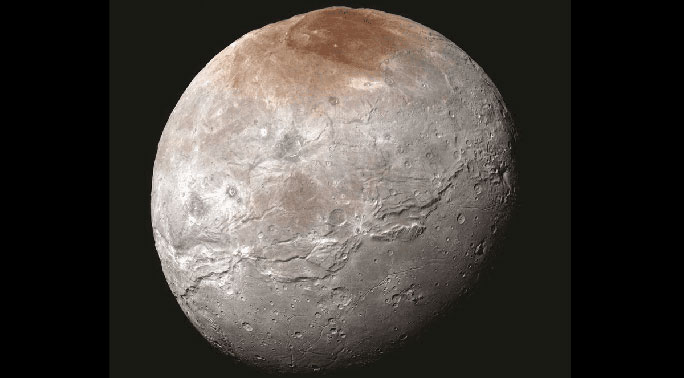The mystery of the 'burnt moon' in NASA's photos
According to Science Alert, scientists initially suspected the iron-colored stain (nicknamed Mordor Macula) was methane gas collected from Pluto's surface, its red color the result of a slow "baking" process in the light. ultraviolet light of the Sun. But that's still just a hypothesis.
A recent study that combined modeling and experiments found that these initial assumptions weren't too far off the mark, with slight variations.

"Scorched Moon" Charon
Planetary scientist Randy Gladstone from the Southwest Research Institute (SwRI) in the US, said: "Prior to NASA's New Horizons spacecraft, the best Hubble images of Pluto revealed only a faint blip of light. of reflected light".
After NASA's ultra-long-range spacecraft arrived, it captured the first clear and ghostly image of a mysterious reddish-brown moon at the North Pole.
Red might not be an unusual color to see on iron-rich worlds like ours or Mars. But on frozen objects at the edge of the solar system, the red color is more likely to indicate the presence of a diverse group of tar-like compounds called tholins.
On Pluto, methane could be the place to start. To grow into tholins, these tiny hydrocarbons need only absorb a very specific color of UV light filtered by orbiting clouds of hydrogen, called Lyman-alpha. And that's how Pluto's pink glow is formed, a subject that has intrigued scientists for decades.
Methane released from Pluto can reach the moon orbiting its orbit and create a red spot. But the competition between Charon's weak gravity and the cold light of the distant Sun is enough to warm Charon's surface to the point of melting the methane ice.
New research adds startling new details that reveal the intimate bond between Pluto and Charon.
To determine what would actually happen, the SwRI researchers modeled the sawing motion of the largely tilted planetary system. They discovered the secret of the red spot could be its explosive properties when spring arrives.
The relatively abrupt warming of the North Pole will take place over several years - just a blink of an eye in Charon's 248-year orbit. During this brief period, a methane fog just tens of microns thick will evaporate at one pole as it begins to freeze at the other.
The model suggests that this rapid motion would be too fast for most of the frozen methane to absorb enough Lyman-alpha to become tholin. But ethane (ethane) - methane's slightly longer hydrocarbon cousin, also obtained by Charon from Pluto - is less volatile and is what gives it the mysterious red color. Only problem is that lyman-alpha radiation won't turn ethane into red mud.
But charged particles emitted from the Sun over a longer period of time can still form increasingly longer chains of hydrocarbons that give Charon its characteristic red stain.
"We think that ionizing radiation from the solar wind will decompose polar ice that is 'cooked' by Lyman-alpha to synthesize increasingly complex, redder materials," said Dr Raut. , responsible for creating the only albedo on this mysterious moon".
Further laboratory testing and modeling could help strengthen the hypothesis that Charon's rouge stain is much more complex than we once realized.
The study was published in the journal Science and Geophysical Research Letters.
- Hypothesis of the life of
- Super moon shines all over the world
- The last supermoon of 2020 illuminates the sky
- See the masterpieces that have given the world
- Beautiful 'super pink moon' images appeared all over the world
- Photo: Manually watch the biggest moon in 20 years
- The beautiful 'super moon' around the world
- NASA announced 8,400 photos of the process of exploring the Moon
- The mystery of the dark side of the Moon
- How to handle when a car burns
- Revealing the mystery of the dark spots on the moon
- No one can find the 'obsessive' cause of these photos
 Van Allen's belt and evidence that the Apollo 11 mission to the Moon was myth
Van Allen's belt and evidence that the Apollo 11 mission to the Moon was myth The levels of civilization in the universe (Kardashev scale)
The levels of civilization in the universe (Kardashev scale) Today Mars, the sun and the Earth are aligned
Today Mars, the sun and the Earth are aligned The Amazon owner announced a secret plan to build a space base for thousands of people
The Amazon owner announced a secret plan to build a space base for thousands of people